- Home
- Garden Wildlife
- Insects
- Beetles
- Dead Wood Beetles
Left: Dorcus parallelipipedus Lesser stag beetle adult male (18-32mm) Right: Larva of stag beetle Lucanus cervus
Life cycle
These beetles lay their eggs on suitable dead or dying trees, mostly during spring-early summer. Female bark beetles create short tunnels under the bark and deposit eggs along the length of this maternal tunnel. On hatching, the larvae create individual tunnels that radiate out from the maternal tunnel. The pattern of these tunnels is often distinctive for a particular bark beetle species. Females of ambrosia-type beetles will seed the maternal tunnel with the fungi and yeasts that will provide sustenance for the larvae. When fully fed, bark beetle larvae pupate at the end of their tunnels. Most bark beetles have one generation a year and overwinter as pupa, with adults emerging in early summer.
Beetle larvae that feed on wood as they tunnel through the branches, trunk or roots of a tree have a diet that is very low in nutrients, so it can take several years before they are ready to pupate. The stag beetle can spend up to five years as a larva. Most wood-boring beetle larvae pupate within their tunnels but stag beetle larvae move out into the soil. They construct an egg-shaped chamber made of soil and wood fragments in which they pupate.
Role of dead wood beetles in gardens
Wood-boring beetles, along with fungal decay, help to break down and recycle dead wood. None of the native wood-boring beetles is a threat to garden plants but some exotic species, such as the Asian longhorn and the citrus longhorn, would be a problem if they become established here, as they have larvae that feed in a wide range of live trees.
Bark beetles associated with ash are likely to do well in the short term as the fungal disease known as ash dieback spreads through Britain and provides breeding sites. This disease is spread by air-borne spores, unlike Dutch elm disease where spores are carried on the adult beetles’ bodies.
The larvae and pupae of bark beetles and wood-boring beetles provide food for woodpeckers. Beetle tunnels that have been vacated after the adult insects have emerged can be taken over by some solitary bees and wasps as nest sites. Even tunnels with a small diameter, such as those made by the common woodworm beetle, can be reused in this way.
Other sources of information
Websites
Mark Telfer's web page on bark beetles
Mark Telfer's web page on longhorn beetles
Website of the Ancient Tree Forum
Books
Hicken, N. E. (1963) The insect factor in wood decay. Hutchinson
By Andrew Halstead reviewed by Andrew Salisbury edited by Steve Head
Dead Wood Beetles
Branches or whole trees and woody shrubs will die in gardens, or dead wood may arise when plants are pruned. Such material is often consigned to the bonfire or a local council waste disposal facilit, but dead wood in the garden is far from "dead" in terms of wildlife value. Many insects, particularly some beetles, are associated with dead wood, or with fungi growing on such material.
The principal beetle families or sub families associated with dead wood in gardens are the Scolytinae or bark beetles (now grouped with the Curculionidae), the Cerambycidae or longhorn beetles, the Ptinidae (formerly the Anobiidae) or woodworm beetles, and the Lucanidae or stag beetles.
![Photo:Fdcgoeul [GFDL (http://www.gnu.org/copyleft/fdl.html) or CC BY 3.0 (https://creativecommons.org/licenses/by/3.0)], from Wikimedia Commons](images/02_Scolytus_scolytus_Imago_rechte_Seite_besser.jpg)
Scolytinae Cerambycidae Ptinidae Lucanidae
Elm bark beetle Wasp longhorn beetle Woodworm beetle Stag beetle (female)
Scolytus scolytus Clytus arietis Anobium punctatum Lucanus cervus
4-6mm long 9-18mm long c5mm long 3-4cm (males to 9cm)
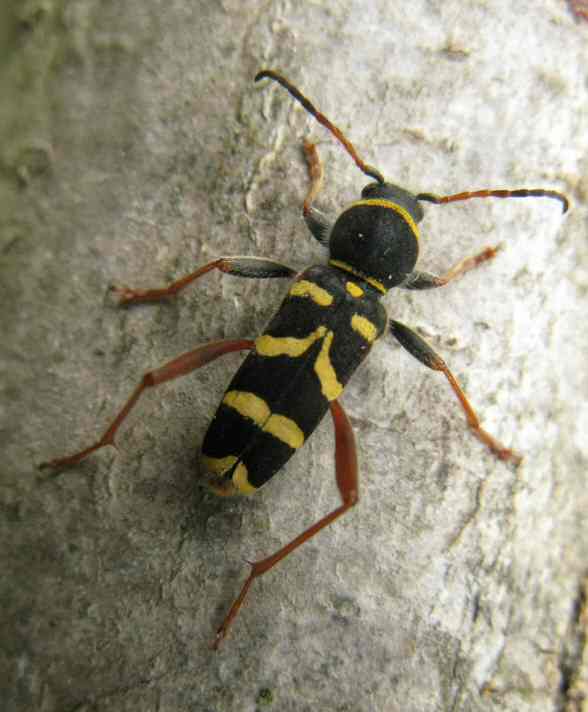
![Photo: CC BY-SA 3.0 (https://creativecommons.org/licenses/by-sa/3.0)], from Wikimedia Commons](images/800px-Anobium_punctatum_above.jpg)
![Photo: Muséum de Toulouse [CC BY-SA 3.0 (https://creativecommons.org/licenses/by-sa/3.0)]](images/lucanus cervus female.jpg)
Species in Britain and Ireland
Bark beetles are often the first colonisers of dead wood and may be active during the dying phase. There are 64 species in Britain and Ireland. They are black or brown cylindrical-shaped beetles, 2-7mm long. The best known species is the elm bark beetle, Scolytus scolytus. This species is the main vector for Dutch elm disease which has killed the great majority of British elms - with profound effects on the landscape.
Most bark beetles have larvae that feed in tunnels they create between the bark and the underlying wood. They need dying or recently dead or felled timber and have no interest in long dead wood. The female beetles often need to feed on live bark or in stems until their ovaries are ready to produce eggs. The larvae of some species, such as Trypodendron domesticum and Xyleborus dispar tunnel into the sap wood where they graze on fungal mycelium that lines their tunnels. This type of scolytid beetle is sometimes called a shot-hole borer or ambrosia beetle.
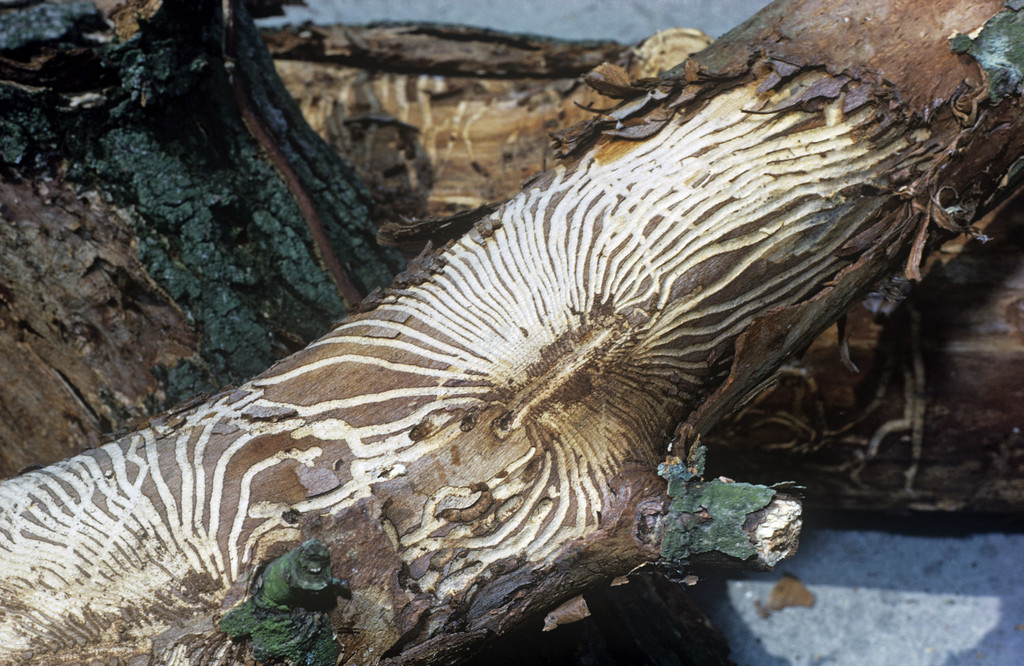
Left: Dead elm tree in Yorkshire. Above: Elm bark beetle Scolytus scolytus larval borings under bark on Elm (Ulmus sp.)
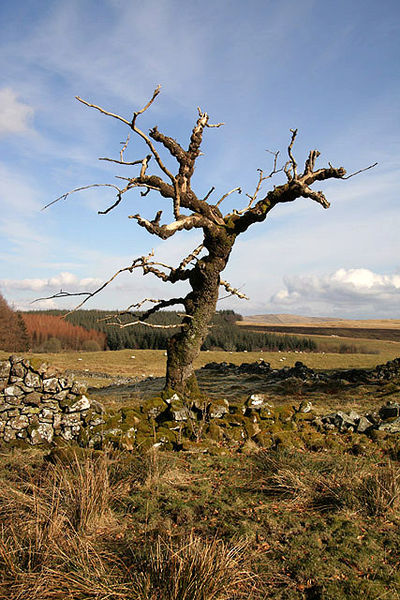
![Photo: Donald Hobern from Copenhagen, Denmark [CC BY 2.0 (https://creativecommons.org/licenses/by/2.0)], via Wikimedia Commons](images/Grammoptera_ruficornis_(18838192865).jpg)
The longhorn beetles number about 67 species, including some non-native species that come into Britain with imported timber and bamboo canes. The smallest native species, Tetrops praeustus, is about 4mm long, while larger species, such as Rutpela maculata, can be 25mm or more. Longhorn beetles are often brightly coloured and most have long antennae, hence the name ‘longhorn’.
Most native species of longhorn beetles have larvae that are associated with dead wood on various broad leaf and coniferous trees, but some develop as larvae in the stems of some non-woody wildflowers, such as thistles and hogweed. The wasp longhorn beetle, Clytus arietis, often develops in dead wood on hazel and wisteria. The adults of some species, such as Grammoptera ruficornis and Stenurella melanura, are often seen in early summer on various flowers, where the adult beetles feed on pollen.
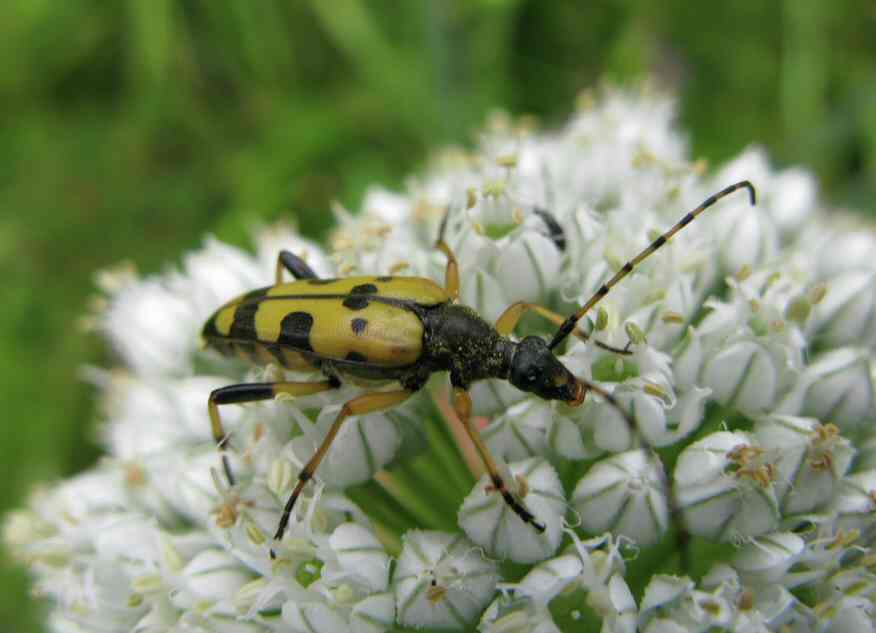
Above left: Grammoptera ruficornis Right: Rutpela maculata black and yellow longhorn beetle
The woodworm family has about 24 small species associated with dead wood. The common woodworm, Anobium punctatum, and the death-watch beetle, Xestobium rufovillosum, are notorious pests of timber and furniture in houses. Their natural habitat is on trees where large pruning cuts or storm damage has removed the bark and allowed the inner wood to dry out sufficiently for these beetles to colonise. There are other species, such as Ptilinus pectinicornis and Hemicoelus fulvicornis that develop in dead wood but pose no threat to wood in buildings.
Woodworm beetles feed as larvae by tunnelling through dead wood of many broad leaf and coniferous trees. The death-watch beetle attracts a mate by tapping its head against the tunnel in which it is residing. This makes a faint but audible ticking noise that can be heard by people under otherwise quiet conditions.
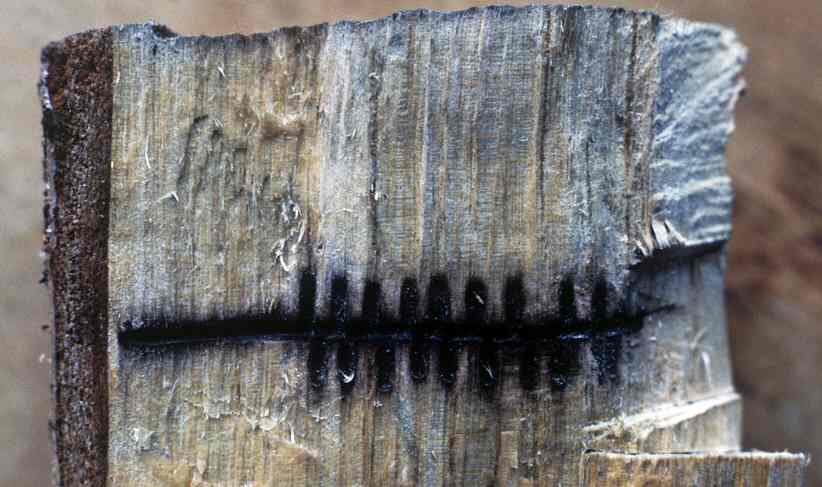
Ambrosia beetles. Above: adult Trypodendron domesticum (about 3.5mm long)
Left: Trypodendron domesticum larval tunnels in Silver birch
![Photo: Siga [GFDL (http://www.gnu.org/copyleft/fdl.html) or CC BY-SA 3.0 (https://creativecommons.org/licenses/by-sa/3.0)], from Wikimedia Commons](images/Ptilinus_pectinicornis_up.jpg)
![Photo: Udo Schmidt from Deutschland [CC BY-SA 2.0 (https://creativecommons.org/licenses/by-sa/2.0)], via Wikimedia Commons](images/Hemicoelus_fulvicornis_(Sturm,_1837)_Syn.-_Anobium_fulvicorne_(Sturm,_1837)_(11422801913).jpg)
Left: Ptilinus pectinicornis 3.5-5.5mm Right: Hemicoelus fulvicornis (previously Anobium fulvicorne) 2.5-4mm
The stag beetle family has four species, two of which may occur in gardens. The most common is the lesser stag beetle, Dorcus parallelipipedus. The stag beetle, Lucanus cervus, is found in areas with well-drained soils in southern England and can be found in urban areas. The stag beetle is Britain’s largest beetle and the male has large pronged mandibles that resemble a stag’s antlers.
The lesser stag beetle has larvae that tunnel in dead wood above ground level, while stag beetle larvae feed in dead roots and tree stumps below ground level. Both are associated with various broad leaf trees. Male stag beetles use their antler-like mandibles to push aside rival males when competing for a female.
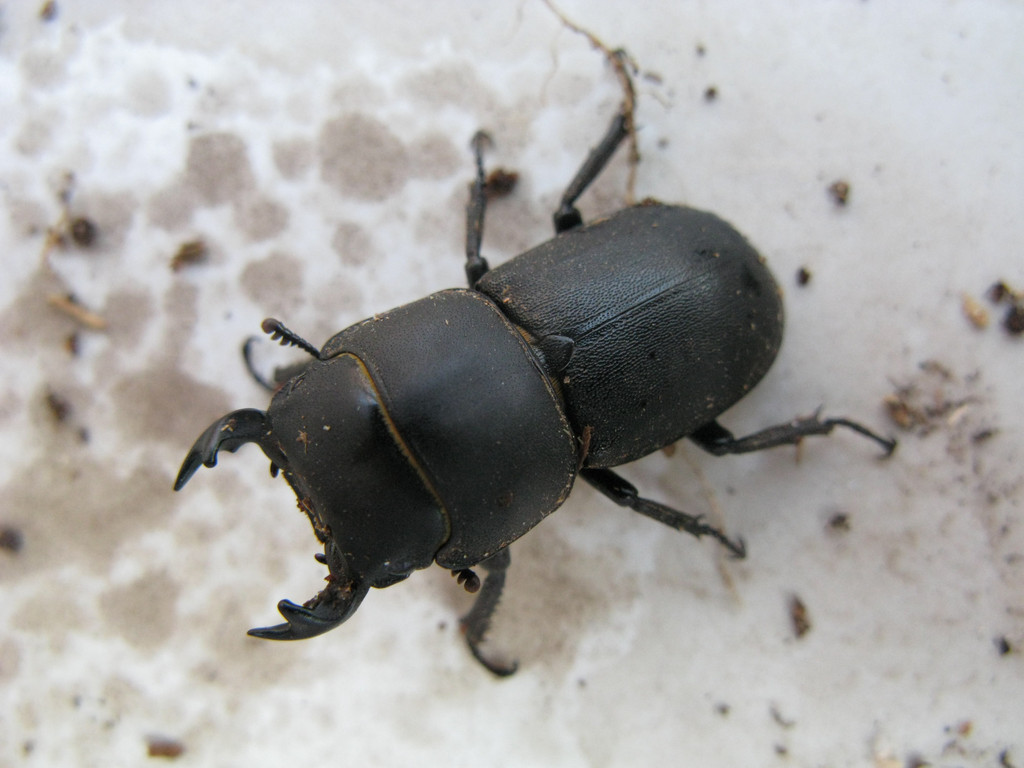
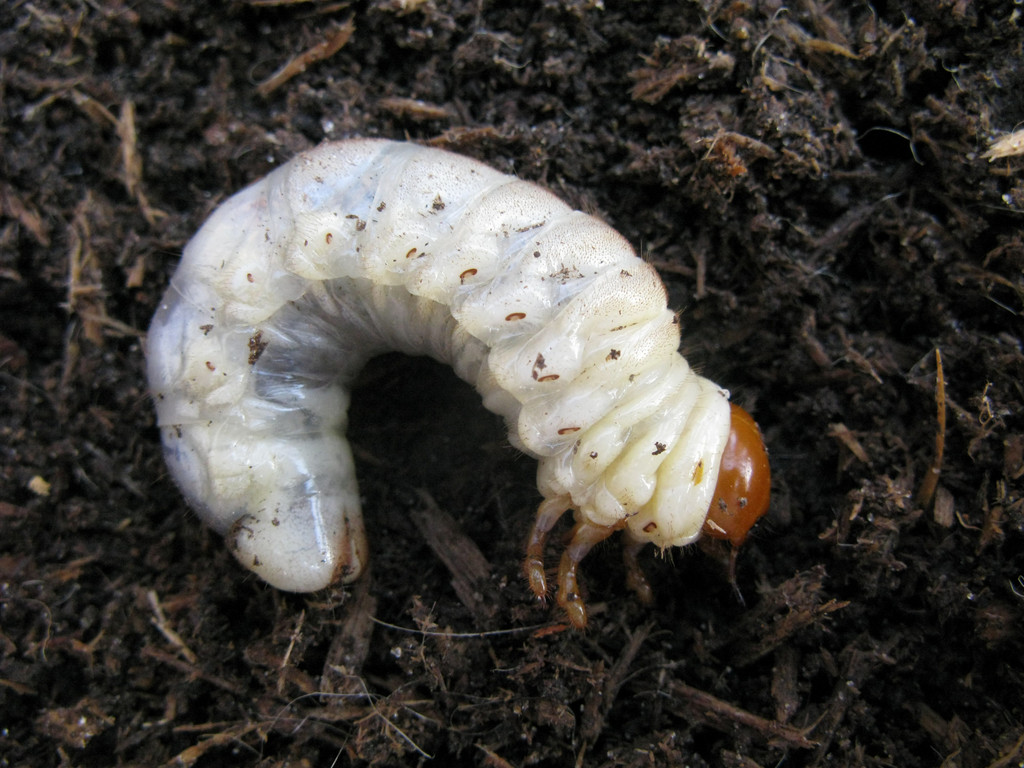
Left: Dorcus parallelipipedus Lesser stag beetle adult male (18-32mm) Right: Larva of stag beetle Lucanus cervus
Life cycle
These beetles lay their eggs on suitable dead or dying trees, mostly during spring-early summer. Female bark beetles create short tunnels under the bark and deposit eggs along the length of this maternal tunnel. On hatching, the larvae create individual tunnels that radiate out from the maternal tunnel. The pattern of these tunnels is often distinctive for a particular bark beetle species. Females of ambrosia-type beetles will seed the maternal tunnel with the fungi and yeasts that will provide sustenance for the larvae. When fully fed, bark beetle larvae pupate at the end of their tunnels. Most bark beetles have one generation a year and overwinter as pupa, with adults emerging in early summer.
Beetle larvae that feed on wood as they tunnel through the branches, trunk or roots of a tree have a diet that is very low in nutrients, so it can take several years before they are ready to pupate. The stag beetle can spend up to five years as a larva. Most wood-boring beetle larvae pupate within their tunnels but stag beetle larvae move out into the soil. They construct an egg-shaped chamber made of soil and wood fragments in which they pupate.
Role of dead wood beetles in gardens
Wood-boring beetles, along with fungal decay, help to break down and recycle dead wood. None of the native wood-boring beetles is a threat to garden plants but some exotic species, such as the Asian longhorn and the citrus longhorn, would be a problem if they become established here, as they have larvae that feed in a wide range of live trees.
Bark beetles associated with ash are likely to do well in the short term as the fungal disease known as ash dieback spreads through Britain and provides breeding sites. This disease is spread by air-borne spores, unlike Dutch elm disease where spores are carried on the adult beetles’ bodies.
The larvae and pupae of bark beetles and wood-boring beetles provide food for woodpeckers. Beetle tunnels that have been vacated after the adult insects have emerged can be taken over by some solitary bees and wasps as nest sites. Even tunnels with a small diameter, such as those made by the common woodworm beetle, can be reused in this way.
Other sources of information
Websites
Website of the Ancient Tree Forum
Books
Hicken, N. E. (1963) The insect factor in wood decay. Hutchinson
Dead Wood Beetles
Branches or whole trees and woody shrubs will die in gardens, or dead wood may arise when plants are pruned. Such material is often consigned to the bonfire or a local council waste disposal facilit, but dead wood in the garden is far from "dead" in terms of wildlife value. Many insects, particularly some beetles, are associated with dead wood, or with fungi growing on such material.
The principal beetle families or sub families associated with dead wood in gardens are the Scolytinae or bark beetles (now grouped with the Curculionidae), the Cerambycidae or longhorn beetles, the Ptinidae (formerly the Anobiidae) or woodworm beetles, and the Lucanidae or stag beetles.
![Photo:Fdcgoeul [GFDL (http://www.gnu.org/copyleft/fdl.html) or CC BY 3.0 (https://creativecommons.org/licenses/by/3.0)], from Wikimedia Commons](images/02_Scolytus_scolytus_Imago_rechte_Seite_besser.jpg)

![Photo: CC BY-SA 3.0 (https://creativecommons.org/licenses/by-sa/3.0)], from Wikimedia Commons](images/800px-Anobium_punctatum_above.jpg)
Left: Dorcus parallelipipedus Lesser stag beetle adult male (18-32mm) Right: Larva of stag beetle Lucanus cervus
Life cycle
These beetles lay their eggs on suitable dead or dying trees, mostly during spring-early summer. Female bark beetles create short tunnels under the bark and deposit eggs along the length of this maternal tunnel. On hatching, the larvae create individual tunnels that radiate out from the maternal tunnel. The pattern of these tunnels is often distinctive for a particular bark beetle species. Females of ambrosia-type beetles will seed the maternal tunnel with the fungi and yeasts that will provide sustenance for the larvae. When fully fed, bark beetle larvae pupate at the end of their tunnels. Most bark beetles have one generation a year and overwinter as pupa, with adults emerging in early summer.
Beetle larvae that feed on wood as they tunnel through the branches, trunk or roots of a tree have a diet that is very low in nutrients, so it can take several years before they are ready to pupate. The stag beetle can spend up to five years as a larva. Most wood-boring beetle larvae pupate within their tunnels but stag beetle larvae move out into the soil. They construct an egg-shaped chamber made of soil and wood fragments in which they pupate.
Role of dead wood beetles in gardens
Wood-boring beetles, along with fungal decay, help to break down and recycle dead wood. None of the native wood-boring beetles is a threat to garden plants but some exotic species, such as the Asian longhorn and the citrus longhorn, would be a problem if they become established here, as they have larvae that feed in a wide range of live trees.
Bark beetles associated with ash are likely to do well in the short term as the fungal disease known as ash dieback spreads through Britain and provides breeding sites. This disease is spread by air-borne spores, unlike Dutch elm disease where spores are carried on the adult beetles’ bodies.
The larvae and pupae of bark beetles and wood-boring beetles provide food for woodpeckers. Beetle tunnels that have been vacated after the adult insects have emerged can be taken over by some solitary bees and wasps as nest sites. Even tunnels with a small diameter, such as those made by the common woodworm beetle, can be reused in this way.
Other sources of information
Websites
Website of the Ancient Tree Forum
Books
Hicken, N. E. (1963) The insect factor in wood decay. Hutchinson
![Photo: Muséum de Toulouse [CC BY-SA 3.0 (https://creativecommons.org/licenses/by-sa/3.0)]](images/lucanus cervus female.jpg)

Scolytinae Cerambycidae
Elm bark beetle Wasp longhorn beetle
Scolytus scolytus Clytus arietis
4-6mm long 9-18mm long
Ptinidae Lucanidae
Woodworm beetle Stag beetle (female)
Anobium punctatum Lucanus cervus
c5mm long 3-4cm (males to 9cm)
Species in Britain and Ireland
Bark beetles are often the first colonisers of dead wood and may be active during the dying phase. There are 64 species in Britain and Ireland. They are black or brown cylindrical-shaped beetles, 2-7mm long. The best known species is the elm bark beetle, Scolytus scolytus. This species is the main vector for Dutch elm disease which has killed the great majority of British elms - with profound effects on the landscape.
Most bark beetles have larvae that feed in tunnels they create between the bark and the underlying wood. They need dying or recently dead or felled timber and have no interest in long dead wood. The female beetles often need to feed on live bark or in stems until their ovaries are ready to produce eggs. The larvae of some species, such as Trypodendron domesticum and Xyleborus dispar tunnel into the sap wood where they graze on fungal mycelium that lines their tunnels. This type of scolytid beetle is sometimes called a shot-hole borer or ambrosia beetle.

Left: Dead elm tree in Yorkshire. Above: Elm bark beetle Scolytus scolytus larval borings under bark on Elm (Ulmus sp.)

Ambrosia beetles. Left: Trypodendron domesticum larval tunnels in Silver birch Right: adult Trypodendron domesticum (about 3.5mm long)
The longhorn beetles number about 67 species, including some non-native species that come into Britain with imported timber and bamboo canes. The smallest native species, Tetrops praeustus, is about 4mm long, while larger species, such as Rutpela maculata, can be 25mm or more. Longhorn beetles are often brightly coloured and most have long antennae, hence the name ‘longhorn’.
Most native species of longhorn beetles have larvae that are associated with dead wood on various broad leaf and coniferous trees, but some develop as larvae in the stems of some non-woody wildflowers, such as thistles and hogweed. The wasp longhorn beetle, Clytus arietis, often develops in dead wood on hazel and wisteria. The adults of some species, such as Grammoptera ruficornis and Stenurella melanura, are often seen in early summer on various flowers, where the adult beetles feed on pollen.

![Photo: Donald Hobern from Copenhagen, Denmark [CC BY 2.0 (https://creativecommons.org/licenses/by/2.0)], via Wikimedia Commons](images/Grammoptera_ruficornis_(18838192865).jpg)
![Photo: Siga [GFDL (http://www.gnu.org/copyleft/fdl.html) or CC BY-SA 3.0 (https://creativecommons.org/licenses/by-sa/3.0)], from Wikimedia Commons](images/Ptilinus_pectinicornis_up.jpg)
![Photo: Udo Schmidt from Deutschland [CC BY-SA 2.0 (https://creativecommons.org/licenses/by-sa/2.0)], via Wikimedia Commons](images/Hemicoelus_fulvicornis_(Sturm,_1837)_Syn.-_Anobium_fulvicorne_(Sturm,_1837)_(11422801913).jpg)
Left: Dorcus parallelipipedus Lesser stag beetle adult male (18-32mm) Right: Larva of stag beetle Lucanus cervus
Life cycle
These beetles lay their eggs on suitable dead or dying trees, mostly during spring-early summer. Female bark beetles create short tunnels under the bark and deposit eggs along the length of this maternal tunnel. On hatching, the larvae create individual tunnels that radiate out from the maternal tunnel. The pattern of these tunnels is often distinctive for a particular bark beetle species. Females of ambrosia-type beetles will seed the maternal tunnel with the fungi and yeasts that will provide sustenance for the larvae. When fully fed, bark beetle larvae pupate at the end of their tunnels. Most bark beetles have one generation a year and overwinter as pupa, with adults emerging in early summer.
Beetle larvae that feed on wood as they tunnel through the branches, trunk or roots of a tree have a diet that is very low in nutrients, so it can take several years before they are ready to pupate. The stag beetle can spend up to five years as a larva. Most wood-boring beetle larvae pupate within their tunnels but stag beetle larvae move out into the soil. They construct an egg-shaped chamber made of soil and wood fragments in which they pupate.
Role of dead wood beetles in gardens
Wood-boring beetles, along with fungal decay, help to break down and recycle dead wood. None of the native wood-boring beetles is a threat to garden plants but some exotic species, such as the Asian longhorn and the citrus longhorn, would be a problem if they become established here, as they have larvae that feed in a wide range of live trees.
Bark beetles associated with ash are likely to do well in the short term as the fungal disease known as ash dieback spreads through Britain and provides breeding sites. This disease is spread by air-borne spores, unlike Dutch elm disease where spores are carried on the adult beetles’ bodies.
The larvae and pupae of bark beetles and wood-boring beetles provide food for woodpeckers. Beetle tunnels that have been vacated after the adult insects have emerged can be taken over by some solitary bees and wasps as nest sites. Even tunnels with a small diameter, such as those made by the common woodworm beetle, can be reused in this way.
Other sources of information
Websites
Website of the Ancient Tree Forum
Books
Hicken, N. E. (1963) The insect factor in wood decay. Hutchinson
By Andrew Halstead reviewed by Andrew Salisbury edited by Steve Head


Left: Ptilinus pectinicornis 3.5-5.5mm Right: Hemicoelus fulvicornis (previously Anobium fulvicorne) 2.5-4mm
The stag beetle family has four species, two of which may occur in gardens. The most common is the lesser stag beetle, Dorcus parallelipipedus. The stag beetle, Lucanus cervus, is found in areas with well-drained soils in southern England and can be found in urban areas. The stag beetle is Britain’s largest beetle and the male has large pronged mandibles that resemble a stag’s antlers.
The lesser stag beetle has larvae that tunnel in dead wood above ground level, while stag beetle larvae feed in dead roots and tree stumps below ground level. Both are associated with various broad leaf trees. Male stag beetles use their antler-like mandibles to push aside rival males when competing for a female.
![Photo: Udo Schmidt from Deutschland [CC BY-SA 2.0 (https://creativecommons.org/licenses/by-sa/2.0)], via Wikimedia Commons](images/Trypodendron_domesticum.jpg)
![Photo: Udo Schmidt from Deutschland [CC BY-SA 2.0 (https://creativecommons.org/licenses/by-sa/2.0)], via Wikimedia Commons](images/Trypodendron_domesticum.jpg)
Above left: Grammoptera ruficornis Right: Rutpela maculata black and yellow longhorn beetle
The woodworm family has about 24 small species associated with dead wood. The common woodworm, Anobium punctatum, and the death-watch beetle, Xestobium rufovillosum, are notorious pests of timber and furniture in houses. Their natural habitat is on trees where large pruning cuts or storm damage has removed the bark and allowed the inner wood to dry out sufficiently for these beetles to colonise. There are other species, such as Ptilinus pectinicornis and Hemicoelus fulvicornis that develop in dead wood but pose no threat to wood in buildings.
Woodworm beetles feed as larvae by tunnelling through dead wood of many broad leaf and coniferous trees. The death-watch beetle attracts a mate by tapping its head against the tunnel in which it is residing. This makes a faint but audible ticking noise that can be heard by people under otherwise quiet conditions.












